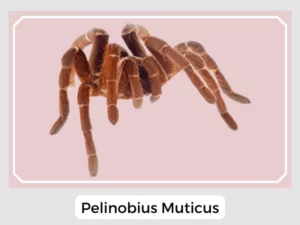The Pelinobius spider family is like a fascinating book full of unique stories. These spiders stand out in the big spider world because of their special features. Here, you’ll learn interesting facts about them.
The eggs of Pelinobius spiders are typically encased in a protective silk sac. The mother usually guards them diligently, ensuring their safety from potential predators.
Pelinobius spiders don’t construct the typical spider web. Instead, they make burrows in the ground and line them with silk to trap prey.
Yes, like many tarantulas and their kin, Pelinobius spiders are venomous. However, their venom is primarily used to subdue prey and is generally not harmful to humans, causing mild irritation at most.
While they can bite if provoked or threatened, Pelinobius spiders are typically not aggressive towards humans. A bite from one might cause temporary discomfort, swelling, or redness, but severe reactions are rare.
Pelinobius spiders play a crucial role in their ecosystems, acting as both predators and prey. By hunting and feeding on various insects and small animals, they help control the populations of these species, maintaining a balanced ecosystem. Their burrowing behavior also contributes to soil aeration, positively impacting plant growth and health.
Natural Predators and Prey-Predator Dynamics: In the wild, Pelinobius spiders face threats from larger predators, including birds and mammals. The balance between these spiders, their prey, and their predators creates a dynamic and interconnected web of life, ensuring the stability of their ecosystems.
Relationship with Humans: Pelinobius spiders, particularly the King Baboon Spider, have caught the attention of pet enthusiasts and researchers alike. While their venom is not deadly to humans, their impressive size, unique behavior, and the rarity of severe reactions to bites make them a subject of fascination. However, their potential for aggression means they are better suited to experienced handlers.
| Distribution | Mostly found in Africa |
| Habitat | Tropical forests, especially near riverbeds |
| Diet | Insects, small mammals, and occasionally birds |
| Lifespan | Approximately 10-15 years in captivity |

In conclusion, in delving into the world of Pelinobius spiders, we uncover a rich tapestry of life, behavior, and ecological significance.
The Pelinobius spider family is like a fascinating book full of unique stories. These spiders stand out in the big spider world because of their special features. Here, you’ll learn interesting facts about them.
The eggs of Pelinobius spiders are typically encased in a protective silk sac. The mother usually guards them diligently, ensuring their safety from potential predators.
Pelinobius spiders don’t construct the typical spider web. Instead, they make burrows in the ground and line them with silk to trap prey.
Yes, like many tarantulas and their kin, Pelinobius spiders are venomous. However, their venom is primarily used to subdue prey and is generally not harmful to humans, causing mild irritation at most.
While they can bite if provoked or threatened, Pelinobius spiders are typically not aggressive towards humans. A bite from one might cause temporary discomfort, swelling, or redness, but severe reactions are rare.
Pelinobius spiders play a crucial role in their ecosystems, acting as both predators and prey. By hunting and feeding on various insects and small animals, they help control the populations of these species, maintaining a balanced ecosystem. Their burrowing behavior also contributes to soil aeration, positively impacting plant growth and health.
Natural Predators and Prey-Predator Dynamics: In the wild, Pelinobius spiders face threats from larger predators, including birds and mammals. The balance between these spiders, their prey, and their predators creates a dynamic and interconnected web of life, ensuring the stability of their ecosystems.
Relationship with Humans: Pelinobius spiders, particularly the King Baboon Spider, have caught the attention of pet enthusiasts and researchers alike. While their venom is not deadly to humans, their impressive size, unique behavior, and the rarity of severe reactions to bites make them a subject of fascination. However, their potential for aggression means they are better suited to experienced handlers.
| Distribution | Mostly found in Africa |
| Habitat | Tropical forests, especially near riverbeds |
| Diet | Insects, small mammals, and occasionally birds |
| Lifespan | Approximately 10-15 years in captivity |

In conclusion, in delving into the world of Pelinobius spiders, we uncover a rich tapestry of life, behavior, and ecological significance.